






Miroslav left HMS Norfolk on the 7 January 1944 a week after the sinking of the Scharnhorst at the Battle of North Cape for officer training at HMS King Alfred (H),
a former leisure centre at Hove near Brighton, requisitioned by the
Navy for training officers for the RNVR. Cadet Ratings did their
initial training at Mowden School in Hove, King Alfred (M), moved on to more advanced training at the former Lancing College, King Alfred (L), and completed their training at King Alfred (H). They were organised into Divisions and Miroslav was a member of Rodney Division. He
completed his officer training on the 6 April 1944, was promoted to
Midshipman, the most junior officer in the Royal Navy, and posted to
HMS Cassandra.
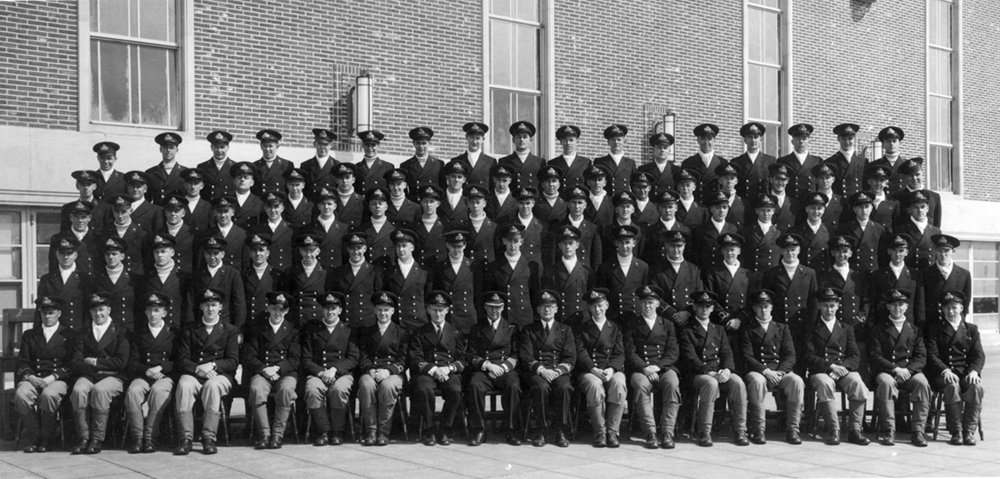
Midshipman M.S. Lansky RNVR was one of three Midshipmen posted to HMS Cassandra (R62), a C Class destroyer built at Scotstoun on the Clyde, in time for its sea trials and commissioning before she joined the 6th Destroyer Flotilla, Home Fleet, at Scapa Flow. One of the other "Mids" was the Hon. Timothy L. Lowther RN, the second son of the 6th Earl of Lonsdale. Miroslav hated the bad weather and the boggy landscape which made it impossible to indulge in his favourite hobby, walking. He felt trapped, was constantly seasick and for a while drank heavily - gin and lime.
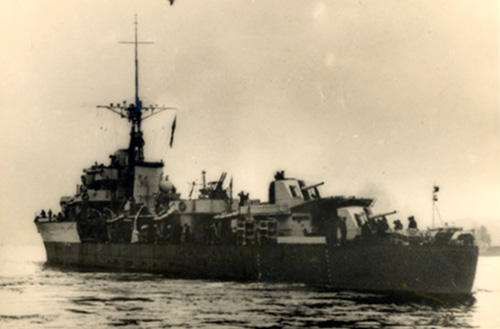
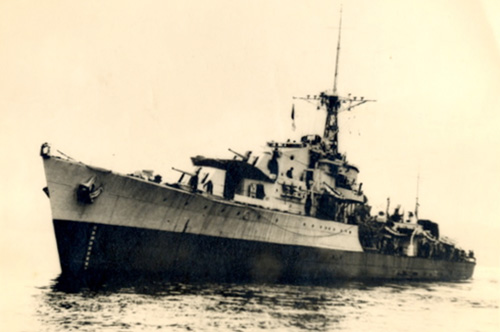
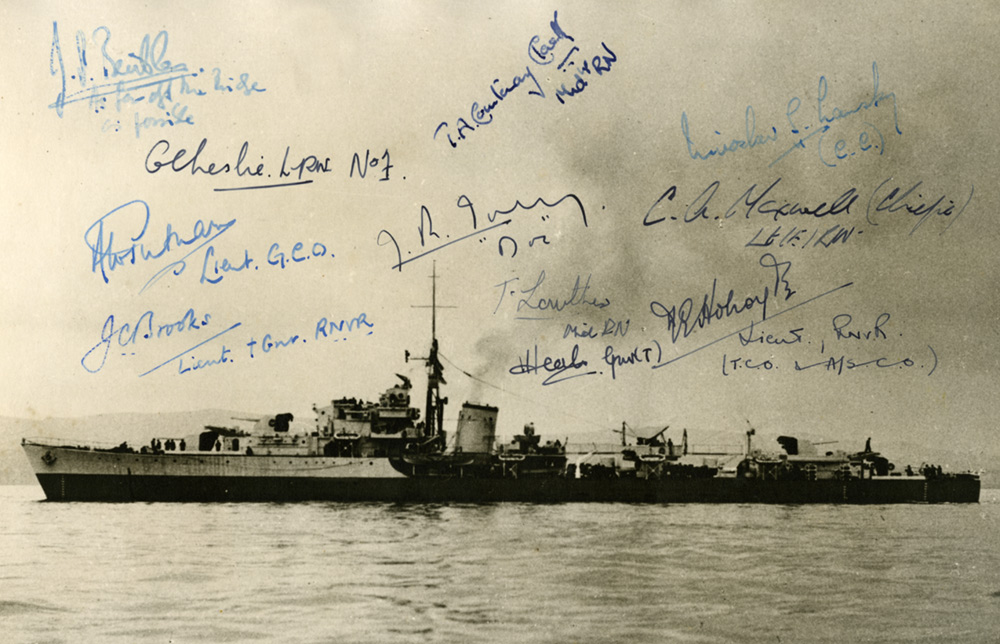
This photograph of HMS Cassandra (R62) was signed by most of its officers soon after the start of its first Commission in 1944
The Commanding Officer, Cdr P.F. Powlett RN, had been replaced as CO by Lt G.C. Leslie RN by the time Cassandra was torpedoed
Miroslav S. Lansky's signature, followed by a cryptic "ee", is top right
Courtesy of Cliff Longfoot of the HMS Cassandra Association
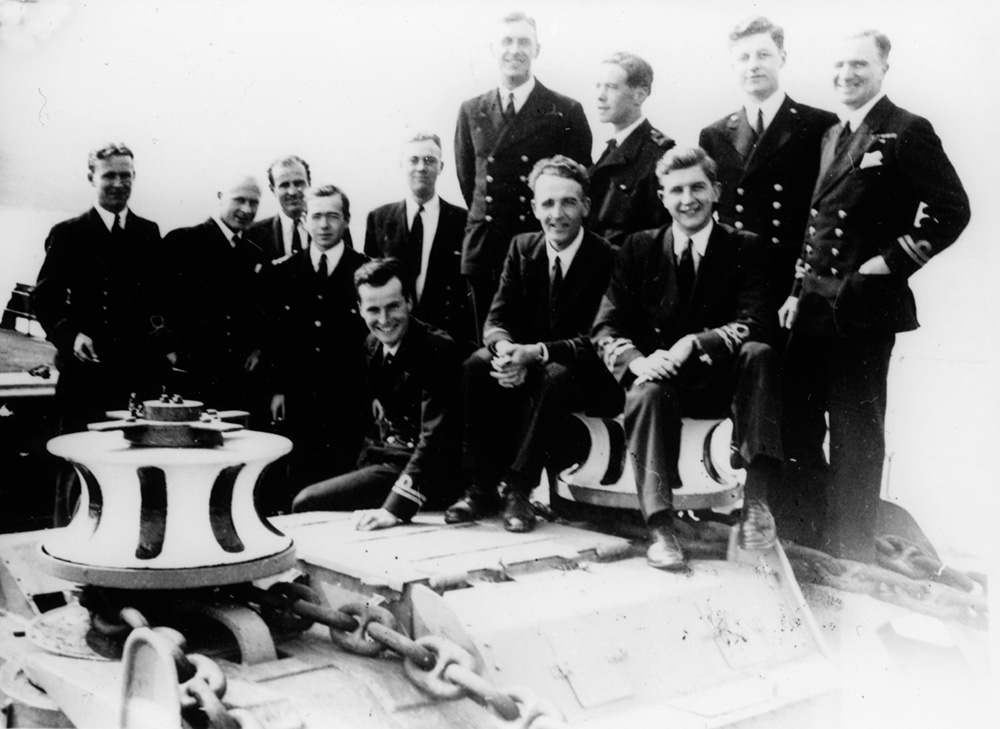
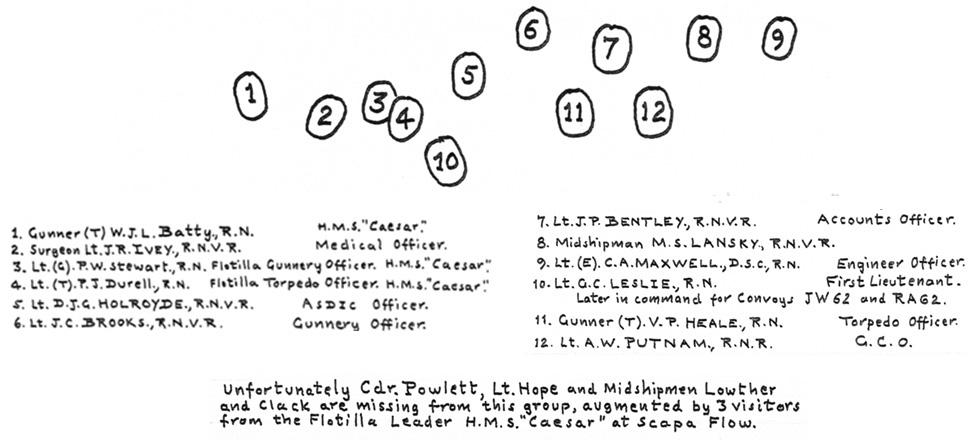
In October 1944 Cassandra
was part of the destroyer screen for the carriers launching air attacks
on the German airbase at Bardufoss in Norway which operated against convoys to
Murmansk on the Kola Inlet in Arctic Russia. On the 2 November Cassandra became a target for these attacks when she escorted the troop carriers, RMS Empress of Australia and RMS Scythia,
taking 11,000 Russian troops captured in Normandy
to Murmansk (Arctic Convoy JW.61A). Most were Prisoners of War (POW)
but some were wearing German uniforms and many, perhaps most, were shot
or sent to labour camps. The
decision to return them to Stalin's Russia was controversial but the
Allies had little alternative if they wanted Stalin to repatriate POWs
overrun in German camps in Poland. Cassandra returned without incident.
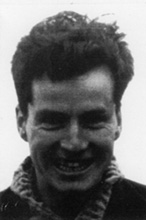
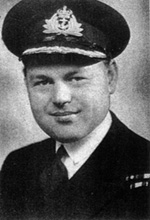 On the 1 December 1944 Cassandra
left the Home Fleet's secure anchorage in Scapa Flow to escort a large convoy of thirty-one 7,000 ton
liberty ships (Convoy JW.62) to Murmansk. The day before leaving the
Flow Cdr P.E. Powlett RN (right) fell down a hatchway and had to be sent to
hospital and the first lieutenant took over as Captain. In
accordance with strict naval tradition Lt. G.C. Leslie’s command (left) became
the junior ship of the destroyer escort and was posted at the tail end,
a position often referred to as the "canteen boat". As such it was more
exposed and vulnerable to attack but the outward
journey was uneventful and no ships were lost.
On the 1 December 1944 Cassandra
left the Home Fleet's secure anchorage in Scapa Flow to escort a large convoy of thirty-one 7,000 ton
liberty ships (Convoy JW.62) to Murmansk. The day before leaving the
Flow Cdr P.E. Powlett RN (right) fell down a hatchway and had to be sent to
hospital and the first lieutenant took over as Captain. In
accordance with strict naval tradition Lt. G.C. Leslie’s command (left) became
the junior ship of the destroyer escort and was posted at the tail end,
a position often referred to as the "canteen boat". As such it was more
exposed and vulnerable to attack but the outward
journey was uneventful and no ships were lost.
Before joining return Convoy RA.62 on the 10 December Cassandra was, ominously, required to carry out a sweep for a known assembly of U-boats in the Kola Inlet. Later that day Cassandra rescued the pilot and observer of a ditched Swordfish plane of 835 Naval Air Squadron launched from the Escort Carrier, HMS Nairana.
That night Cassandra was
torpedoed by U-365 (commanded by Lt Dieter Todenhagen) in position 71°
57” N, 32° 04’ E, approximately 190 miles NNW of Murmansk. OD Dudley
Mills was in the chart room and all he heard was a dull thud but soon after the torpedo struck "the whole scene was
brilliantly illuminated by a 'snowflake' flare fired by another ship,
perhaps Caprice,
making us a 'sitting duck' as we lay there in the confused sea with
engines stopped. Looking forward, I could see that the blast shield on
'B' gun deck had been bent back and forced up into a vertical position,
but the most astounding thing was that there was nothing beyond. No
fo'c'stle, no bows, no 'A' gun. Everything had completely disappeared,
there was just the sea foaming in the harsh magnesium light. The
'snowflake' burned out and the scene was plunged into darkness again
except for the fighting lights. I went back into the Charthouse, shaken
to the core."
Miroslav
was awake, he heard a "tremendous thud", ran outside, and could not
understand what had happened at first. Then he saw that the bow of the
boat was no longer there. There was no debris, no bodies in the water,
just a gapping emptiness where the bow should have been. The
entire
bow ahead of the forward magazine,
including 'A' gun turret was blown off and the structure abaft this to
the forward bulkhead of the fuel tanks was wrecked. CPO Sidney Lay,
Stoker, described how “It was necessary to shore up the bulkhead which
was exposed to the sea. This was done by the damage control parties,
led by the Chief Stoker, CPO Willis, and when the job was finished it
looked just like a giant chessboard, so well had the work been done.” Cassandra was taken in tow (stern first at three knots) by the British Colony Class frigate HMS Bahamas
(T/A/Lt.Cdr. W.S. Thomson, RNR). Dudley
Mills recalled "watching the towing wire dipping into the sea over most
of its length and at times almost loosing sight of Bahamas as she slid down into a trough with only her masthead showing above the angry waves before climbing up out again. But there, way towards the horizon, was the reassuring sight of her sister ship Somaliland ceaselessly circling us in a protective ring, together with Tortola." Later the tow was passed over to a
Soviet tug which brought her into the Kola Inlet. Sixty
two men, one third of the ship's company, lost their
lives in this attack on the destroyer with pennant number R62 while escorting Convoy RA.62, all
of them ratings from the mess decks in the bow. Two days later the
U-boat was destroyed, with all
hands lost, by a Fairey Swordfish aircraft launched from HMS Campania.
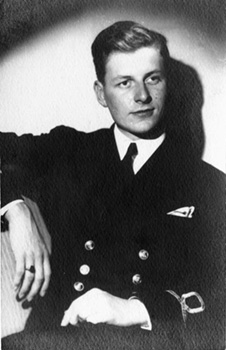 The British Admiral at Murmansk persuaded the Russians to clear the dry dock at Rosta for Cassandra
and "as it was pumped down dozens of 'Zombie' like Russian dockyard
workers swarmed aboard." Roberts described how “the following day the
Coxwains party extracted the dead from the tangled mess of what
remained of the bow section, severed from behind the B Gun. The party
was given a special rum issue for this unpleasant task. The following
morning I formed part of the burial party, the service being taken by
the Captain, Lieutenant Leslie RN. We sailed in a trawler to the mouth
of the Kola Inlet where the burials took place.” The injured were taken
to the Royal Navy Hospital at Vaenga. Most of the officers
and crew returned to Britain aboard HMS Bahamas and HMS Somaliland on
the 15 December. Midshipman Lansky was promoted to Acting Sub
Lieutenant on the 19 December 1944 and remained in Murmansk for some
weeks, an opportunity to pickup Russian ("that was an easy language")
but remembers very
little apart from buying "a moth eaten Shapka" (a
fur hat with ear flaps) to try and keep warm. The studio photograph on
the right with the single ring of a sub lieutenant was taken after his
return.
The British Admiral at Murmansk persuaded the Russians to clear the dry dock at Rosta for Cassandra
and "as it was pumped down dozens of 'Zombie' like Russian dockyard
workers swarmed aboard." Roberts described how “the following day the
Coxwains party extracted the dead from the tangled mess of what
remained of the bow section, severed from behind the B Gun. The party
was given a special rum issue for this unpleasant task. The following
morning I formed part of the burial party, the service being taken by
the Captain, Lieutenant Leslie RN. We sailed in a trawler to the mouth
of the Kola Inlet where the burials took place.” The injured were taken
to the Royal Navy Hospital at Vaenga. Most of the officers
and crew returned to Britain aboard HMS Bahamas and HMS Somaliland on
the 15 December. Midshipman Lansky was promoted to Acting Sub
Lieutenant on the 19 December 1944 and remained in Murmansk for some
weeks, an opportunity to pickup Russian ("that was an easy language")
but remembers very
little apart from buying "a moth eaten Shapka" (a
fur hat with ear flaps) to try and keep warm. The studio photograph on
the right with the single ring of a sub lieutenant was taken after his
return.
Dudley Mills was part of the small maintenance crew who stayed with their ship amidst "a landscape of snow covered low rocky hills with patches of dense woodland" where some crew members learned to use borrowed skies. On Christmas Day they were invited to the Wardroom in the late forenoon and "served a most lethal Punch, concocted from from almost every bottle left in the Wardroom store". Dudley was a member of the KKK, the "Kassandra's Kola Klowns", run by ABs Dick Collyer and Len Shaw who were ordered to put on a show at the Intourist Club in Murmansk, one of the few places set aside for the entertainment of foreigners, when the next convoy arrived. They occasionally took the old steam train into Murmansk to see Russian films at the cinema or newer American films at the Red Navy Club in Vaenga. At this time of the year the sun never rose and long term staff at the RN Hospital in Vaenga often suffered from depression and some severe cases had to be sent home as unfit for duty.
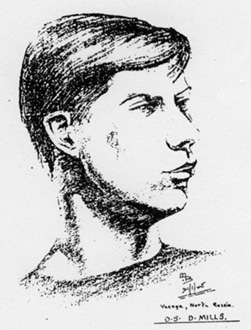
HMS Cassandra remained under repair at Murmansk until April 1945. “The steel which was sent from England to fabricate a dummy bow was sunk every time. Eventually the Russians decided to use their own steel to build it and watching it being welded on by men and women, just youngsters, I never thought it would stand the strain of the voyage home but on arrival at Rosyth there was not enough water in the ship to fill a bucket” (Sidney Lay).
The
sketch of Cassandra with its bow blown off (below) was made by Dudley J Mills (C/JX 425692) and his detailed
account of that night and the months following while Cassandra was under repair can be read in full on this web site. "Dudley was rated Ordinary Seaman. Cassandra
was his only ship. He had trained to be an officer but the attrition
rate on D Day was not as expected and he was not commissioned. He spent
his working life with the Thames Water Board. Later in life he married
the widow of Bob Fisher one of his shipmates" (Cliff Longfoot). His portrait on the left was drawn by Morris Birkett at the RN Hospital in Vaenga.
| Lt G.C. Leslie RN - Commanding Officer | Lt J.P. Bentley RNVR - Accounts Officer |
| Lt F.S. Hope RN - First Lieutenant |
Surgeon Lt J.R. Ivey RNVR - Medical Officer |
| Lt (E) C.A. Maxwell DSC, RN - Engineer Officer |
Mid Miroslav S. Lansky RNVR |
| Gunner (T) V.P. Heale RN - Torpedo Officer |
Mid the Hon. T.L. Lowther RN |
| Lt D.J.G. Holroyde RNVR - ASDIC Officer | Mid T.A.C. Clack RN |
| Lt J.C. Brooks RNVR - Gunnery Officer | Lt A.W. Putnam RNR - Gunnery Control Officer |
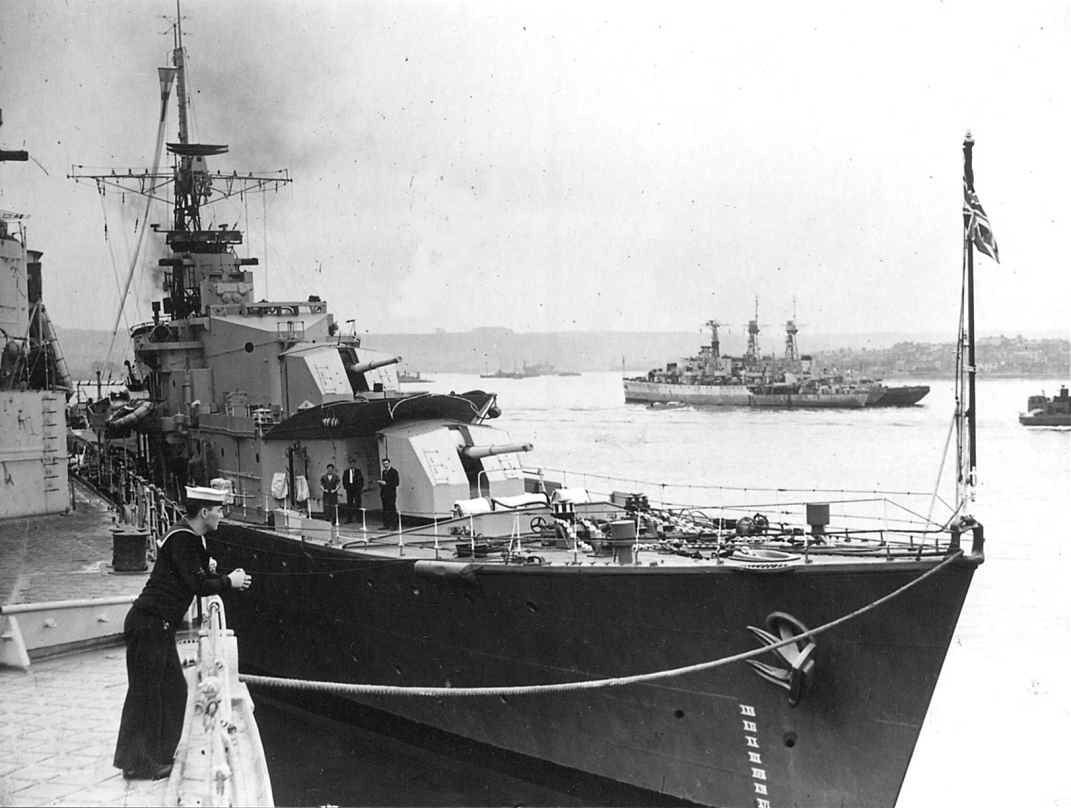
This photograph of HMS Cassandra was taken near Plymouth in the 1950s looking down the Tamar to Torpoint but its appearance is little changed from 1944
HMS Cassandra remained in service until 1966 and the HMS Cassandra Association includes crew members from 1944 when it was torpedoed by U-365 near Murmansk
Courtesy of www.navyphotos.co.uk
Miroslav
can't recall the name of the ship on which he returned to Scapa Flow
but it too was attacked and Miroslav had another brush with death when
the man in the bunk below was "blown away" leaving a gaping hole in the
deck. After survivors
leave he was posted to HMS Venomous at Rosyth on the 20 February 1945 in response to a puzzling but urgent request for an officer who could speak Russian. Venomous was an elderly V & W Class destroyer built in 1919, twenty five years before HMS Cassandra.
Stripped of most of its armament and with one of its two boilers (and
funnels) removed she had spent a dull six months in the Irish sea
towing targets for Barracuda aircraft based in the Isle of Man to attack with unarmed torpedoes before nearly being lost with all hands in a hurricane on the East coast of Scotland.
But Sub Lt Miroslav Lansky RNVR joined Venomous in time to take part in Operation Apostle,
the despatch of destroyers with accompanying minesweepers to accept the
surrender of German naval forces in six Norwegian ports. HMS Venomous and HMS Valorous were despatched to Kristiansand South on an inlet off the Skagerack the deepwater channel between Norway and Denmark.
When I contacted Miroslav Stanley Lansky (1925 - 2014) he was the last officer alive who served in HMS Cassandra when she was torpedoed on the 11 December 1944 and HMS Venomous
when she accepted the surrender of
German naval forces at Kristiansand in Norway on the 15 May 1945. He was in poor health and I
relied on his wife, Evelyn Lansky, and daughter Tamara Lansky, to help me tell
his story.
Click on the link to read Dudley Mill's detailed description of the torpedoing of HMS Cassandra
and events after it was towed into Murmansk. Peter Erwood's edited account of survivors for the
6th Destroyer Flotilla Association, A Long Night for the Canteen Boat: The torpedoing and salvage of HMS Cassandra December 11 1944 (Arcturus
Press, 1996) is no longer in print. HMS Cassandra was a sister ship of HMS HMS Cavalier,
the only surviving wartime destroyer of the Royal Navy, which is
preserved in Chatham's historic naval dockyard "as a memorial to 142
Royal Navy destroyers sunk during the Second World War and over 11,000
men who lost their lives as a result". HMS Cassandra and HMS Cavalier were C Class Destroyers and their story is told by David Hobbs in 'C' Class Destroyers (Maritime Books, 2012).
I should also acknowledge the invaluable assistance of Cliff Longfoot, the Secretary of the HMS Cassandra
Association, whose members met annually at the D Day Museum in
Southsea on the 11 December to lay a wreath on the memorial to the 62
crew members who were killed on that day in 1944. The memorial is now at the Chatham Naval Dockyard and the HMS Cassandra Association has been wound up.
Part 3: HMS Venomous and the surrender of German Naval Forces at Kristiansand
Part 1: A rating on HMS Norfolk at the Battle of the North Cape, Christmas 1943